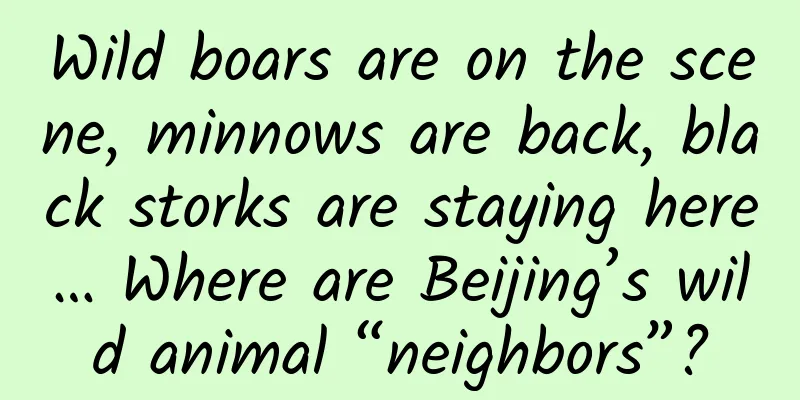Wild boars are on the scene, minnows are back, black storks are staying here… Where are Beijing’s wild animal “neighbors”?

|
Not long ago, a wild boar broke into a residential area in Shijingshan, Beijing, attracting many curious citizens to watch. As ecological protection efforts are strengthened, incidents of wild animals appearing are increasing year by year. Are we ready to "coexist peacefully" with them? Written by Li Peng, Photo and text edited by Chen Yongjie New Media Editor/Fang Yongzhen On July 22, a wild boar broke into the courtyard of No. 66 Rongjingcheng in Shijingshan District, Beijing, and ran around everywhere, attracting many curious citizens to watch. Seeing that someone was surrounding it, the wild boar also broke an iron fence in the community while escaping. ▲Pictures of wild boars taken by residents (Photo source: Beijing Shijingshan WeChat official account) In recent years, due to the strengthening of ecological protection efforts, wild boars, which were rarely seen before, have become quite common in rural residential areas. However, it is still very surprising to see them appear in densely populated areas in a metropolitan city like Beijing. In fact, wild boars are widely distributed in Beijing, and they are found in several districts, including Mentougou, Fangshan, Miyun, Pinggu, Yanqing, etc. With the improvement of the ecological environment, more and more wild boars have slowly spread to the surrounding areas in recent years, so some individuals have been driven away by their families to find new territories, but it is still an accidental phenomenon for wild boars to come to the city. However, the wild boars entering Beijing reflect the continuous improvement of the urban ecological environment since the beginning of the new century. Wild animals are becoming more and more common in cities. It has become an issue that cities and their residents must learn to live in harmony with more and more wild animals. Wildlife in cities is increasing In traditional thinking, except for wild animals in zoos, wild animals live in mountains, forests and the countryside. Zhou Haixiang, deputy director of the Scientific Investigation Committee of the China Wildlife Conservation Association, said that with the improvement of the ecological environment in recent years, the area of urban green space and parks has continued to increase, and more and more small lakes and wetlands in the city have been restored, and the distance between cities and nature has become closer. In addition, wildlife protection laws and regulations are constantly being improved, and people's awareness of animal protection is constantly increasing, which has provided squirrels, hedgehogs, weasels, badgers and many other smaller wild animals with the conditions to become "citizens". The reduction in the use of pesticides and the increase in the number of insects have also allowed more birds to live in cities. In June this year, the Chinese goral, a native goat of Beijing, appeared in the alley on the south side of the Beijing Coal Group General Hospital in Mentougou District. The Chinese goral is a national second-class protected animal. It is difficult to see its true appearance on weekdays. Its living environment is deep forest cliffs. Therefore, the appearance of the Chinese goral in Mentougou this time is even more surprising. In the community where the author lives, hedgehogs and yellow weasels have also been seen many times. Since the beginning of 2021, some wildlife observers have repeatedly discovered the golden-lined side-folded frog in Beijing's Yuyuantan Park, Green Dike Park, and Liangshui River Basin. This creature was once thought to be extinct. ▲Chinese goral (Photo source: Beijing News) People living in Jiangsu and Zhejiang, especially Shanghai, may know such an animal: it has big dark circles under its eyes and brown fur, looks like a raccoon, and is often mistaken for a raccoon. In fact, it is a canine called raccoon, which is widely distributed in Northeast and Southern my country. In some cities, represented by Shanghai, there are also a small number of raccoon dogs. In Songjiang District in the southwest of Shanghai, there are 78 residential areas, parks, urban green spaces and other plots where raccoon dogs can be found, making it the urban area with the widest distribution of raccoon dogs. There are also some wild animals living in the mountains and forests on the outskirts of cities. They thrive in the cracks of the human world and gradually become new neighbors of urban residents. During the day, they hide in the corners and cracks of the city; when night falls and the lights in the office buildings go out, they begin to come out in groups of three or five to move around and forage. The increase in wild animals in some cities is also closely related to the new coronavirus epidemic. Since the outbreak of the epidemic, many communities have been sealed off and human activities have been relatively reduced. As a result, the phenomenon of "people retreat and birds enter" and "people retreat and animals enter" has emerged. Some creatures that were previously difficult to find in the mountains are now showing traces in urban areas. Living as a “neighbor” with wild animals The increasing number of wild animals in cities does not always mean that the species is increasing. Hedgehogs are one example. Although some people may occasionally see hedgehogs in the cities where they live, their survival is actually in a critical situation. Since 2000, the number of wild hedgehogs has dropped by 30% due to habitat loss and human hunting. They are now listed as endangered by the International Union for Conservation of Nature (IUCN). Therefore, wild animals like hedgehogs need more care from us humans. In fact, for most wild animals, cities are not ideal places to live. Wild animals living in cities often face many unfavorable factors such as traffic accidents, noise, light noise, environmental pollution, etc., and are easily harmed. And with the development of urbanization, the living space of wild animals in some cities is constantly shrinking. For example, wild animals such as bats, ducks, and frogs are becoming increasingly difficult to find; the light reflection of the glass curtain walls of high-rise buildings in cities has caused tragedies of birds being killed due to misjudgment; it is not uncommon for motor vehicles to run over small animals... Therefore, it is not easy for wild animals to survive in cities, and protecting wild animals in cities faces greater challenges than in the wilderness. What should we do when facing wild animals? Experts say we can love wild animals, but we should not love them wrongly. Guo Geng, a researcher at the Beijing Biodiversity Conservation Center, said that the most important thing for us to be neighbors with wild animals in cities is to keep a distance from them. Do not capture or feed them at will, and do not keep them as pets. ▲Some wildlife observers have found the golden-lined sidefold frog many times in Beijing's Yuyuantan Park, Ludi Park, and Liangshui River Basin (Photo by Luo Hao) Scientific research has proven that close contact between humans and wild animals involves certain two-way risks: wild animals may transmit unknown pathogens and viruses to humans, leading to zoonotic diseases or even epidemic infectious diseases, increasing health risks; at the same time, overly close contact between humans and wild animals goes against the habits of wild animals and will threaten the survival of their wild populations. Zhou Haixiang said that people and wild animals in cities should live in peace and try not to interfere with each other. In the view of some wildlife conservationists, urban residents need to establish a concept that cities belong not only to the people living there, but also to the numerous wild animals. The urban landscape can be more "wild" "Without the hustle and bustle of the world, without the neatness of farmland/The sight is filled with weeds and trees, the seasons change/The ears are filled with the chirping of birds and the buzzing of insects, the order of day and night/The fallen petals are colorful, each with a different look/The sparse shadows are slanting, mottled..." This is a sentence from a poem about the wilderness - "Confessions of the Wilderness", from which we can glimpse the wildness of nature and the freedom of species. But over the years, we have often advocated for exquisite artificial landscapes in the transformation of urban landscapes. From a visual perspective, they often look better. However, in the eyes of some wildlife conservation scholars and ecological experts, such transformation is actually not friendly to many wild animals, because wild animals prefer wild environments, which are more conducive to their survival and reproduction. Guo Geng and other animal protectionists suggest that when cities build or renovate some parks, they should also fully consider the survival and reproduction of wild animals, and try not to destroy their living environment during renovation and construction. It is necessary to appropriately preserve wilderness areas. Otherwise, renovation will be a disaster for many wild animals. In fact, Beijing has taken action in recent years. In the past, ground cover herbaceous plants in Beijing were often removed as weeds, but in recent years, Beijing has gradually let ground cover herbaceous plants "return home" and reserved some wasteland for these plants to grow. The more typical ones are the Olympic Forest Park and the Temple of Heaven Park, among which the February orchids in the Temple of Heaven Park are particularly popular with tourists. In addition, in some parks, wild grasses were mostly cut in winter in the past, but now they are also preserved and can be used as winter landscapes for tourists to take pictures. At the same time, some grass seeds can also provide food for birds, protecting biodiversity. The effect of this measure is also obvious. Guo Geng gave an example, saying that in Beijing Milu Park there is a wilderness area called Taohua Island, which is a dried-up and abandoned fish pond. For many years, he repeatedly stressed that it should not be disturbed. Now this overgrown area has become a hiding place and courtship ground for musk deer. ▲In 2019, the long-lost minnow appeared in the West Changhe River of Yuanmingyuan for the first time (Photo by Luo Hao) Guo Geng said that the current park construction in Beijing has emphasized the wilderness of parks, requiring at least 10% of the area to be reserved for wildlife as buffers and habitats. This is fortunate for the wildlife living in many parks in Beijing. Produced by: Science Central Kitchen Produced by: Beijing Science and Technology News | Beijing Science and Technology Media Reproduction without authorization is prohibited, and offenders will be prosecuted |
>>: “The first bucket of milk tea in autumn”, will it save life or kill you?
Recommend
China Automotive Power Battery Industry Innovation Alliance: Ranking of domestic power battery manufacturers in January 2022
Recently, the China Automotive Power Battery Indu...
Editing, algorithms and social media, content distribution divided into three parts?
Let me first put forward my personal conclusion: ...
Should you take antibiotics immediately if you have pneumonia? Can't eat frozen steamed bread? Here comes the list of scientific rumors in November 2024 →
1. If you get pneumonia, do you need to take anti...
How to arouse users’ desire for products?
When we hear about or see a very good new product...
5G mobile phones are selling like hot cakes! Netizens: It’s useless if the signal and package can’t keep up
During this year's Double 11, mobile phones w...
Google officially mentions Android 11 for the first time
On October 11, according to foreign media reports...
World Day to Combat Desertification and Drought丨Greening and sand retreating! See the green territory continue to expand
Desertification is a major global ecological prob...
Lu Cheng's psychological lesson on parenting and self-healing
Lu Cheng's parenting and self-healing psychol...
From power outages to world standards, this technology opens up the "high-speed railway" of electricity
From power outages due to poverty to 24-hour brig...
Xiaohongshu product analysis report!
Xiaohongshu is known as a popular shopping tool f...
Ten thousand words of operational knowledge: How to plan an efficient marketing and operation plan?
In recent years, mobile Internet has developed ra...
User Activation: Breaking Down Luckin Coffee’s New User Activation Process
There are many ways to attract new customers to y...
How to improve the effectiveness of Baidu bidding promotion?
How to make Baidu bidding promotion more effectiv...
Douyin e-commerce live broadcast review manual
A few days ago, I posted a message on WeChat Mome...
5 core skills that a novice needs to advance to an operations expert
In recent years, operations positions have been v...









